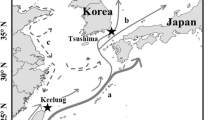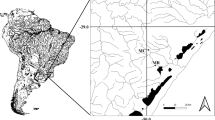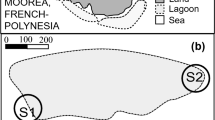Abstract
Latitudinal variations in fitness-related traits have been reported in a variety of organisms. Intraspecific comparison of such traits among populations living under different environmental conditions is an effective approach for elucidating the cause and consequences of such latitudinal variations. In the present study, population demography, seasonal changes in somatic and reproductive conditions, and the occurrence of egg-brooding males were investigated in the seaweed pipefish, Syngnathus schlegeli, collected monthly in the Seto Inland Sea, Japan, in order to estimate the reproductive season and mating pattern. The findings were then compared with those reported for a population in Otsuchi Bay, northern Japan. We found that the reproductive season is longer in the Seto Inland Sea population (March–November) than in the Otsuchi Bay population (May–October), although reproductive activity may temporarily cease during August in the Seto Inland Sea population. Males of the Seto Inland Sea population brooded eggs that were at the same developmental stage, suggesting that males mate with only one female in a single brooding episode (i.e., monogamy)—in contrast to the Otsuchi Bay population, where a portion of males brooded eggs consisting of multiple clutches at different developmental stages, suggesting that multiple females contribute to a single brood (i.e., polygamy). Additionally, we found that the standard lengths of both males and females are approximately 30 mm smaller in the Seto Inland Sea than in the Otsuchi Bay population. These results suggest that the multiple mating by males in a single brood and the larger body size in the Otsuchi Bay population are results of fecundity selection on life history and behavioral traits to adapt to the shorter reproductive season and lower reproductive efficiency in this relatively cold environment.




Similar content being viewed by others
References
Ahnesjö I (1995) Temperature affects male and female potential reproductive rates differently in the sex-role reversed pipefish, Syngnathus typhle. Behav Ecol 6:229–233
Ashton KG (2002) Patterns of within-species body size variation of birds: strong evidence for Bergmann’s rule. Global Ecol Biogeogr 11:505–523
Atkinson D (1994) Temperature and organism size: a biological law for ectotherms? Adv Ecol Res 25:1–58
Atkinson D, Sibly RM (1997) Why are organisms usually bigger in colder environments? Trends Ecol Evol 12:235–239
Belk MC, Houston DD (2002) Bergmann’s rule in ectotherms: a test using freshwater fishes. Am Nat 160:803–808
Bennett S, Bellwood DR (2011) Latitudinal variation in macroalgal consumption by fishes on the Great Barrier Reef. Mar Ecol Prog Ser 426:241–252
Bergmann C (1847) Über die Verhältnisse der Wärmeökonomie der Thiere zu ihrer Grösse. Gottinger Studien 3:595–708
Bolland J, Boettcher A (2005) Population structure and reproductive characteristics of the Gulf pipefish, Syngnathus scovelli, in Mobile Bay, Alabama. Estuaries 28:957–965
Campbell BC, Able KW (1998) Life history characteristics of the northern pipefish, Syngnathus fuscus, in southern New Jersey. Estuaries 21:470–475
Claireaux G, Webber DM, Kerr SR, Boutilier RG (1995) Physiology and behaviour of free-swimming Atlantic cod (Gadus morhua) facing fluctuating temperature conditions. J Exp Biol 198:49–60
Conover DO (1992) Seasonality and the scheduling of life history at different latitudes. J Fish Biol 41B:161–178
Côté D, Moulton S, Frampton PCB, Scruton DA, McKinley RS (2004) Habitat use and early winter movements by juvenile Atlantic cod in a coastal area of Newfoundland. J Fish Biol 64:665–679
Foster SA, Endler JA (1999) Geographic variation in behavior. Oxford University Press, New York
Walther G-R, Post E, Convey P, Menzel A, Parmesan C, Beebee TJC, Fromentin J-M, Hoegh-Guldberg O, Bairlein F (2002) Ecological responses to recent climate change. Nature 416:389–395
Fukumori K, Okuda N, Hamaoka H, Fukumoto T, Takahashi D, Omori K (2008) Stable isotopes reveal life history polymorphism in the coastal fish Apogon notatus. Mar Ecol Prog Ser 362:279–289
Gillooly JF, Charnov EL, West GB, Savage VM, Brown JH (2002) Effects of size and temperature on developmental time. Nature 417:70–73
Haresign TW, Shumway SE (1981) Permeability of the marsupium of the pipefish Syngnathus fuscus to [14C]-alpha amino isobutyric acid. Comp Biochem Physiol 69A:603–604
Kokita T (2003) Potential latitudinal variation in egg size and number of a geographically widespread reef fish, revealed by common-environment experiments. Mar Biol 143:593–601
Kvarnemo C (1994) Temperature differentially affects male and female reproductive rates in the sand goby: consequences for operational sex ratio. Proc R Soc Lond B 256:151–156
Lourie SA, Vincent ACJ (2004) A marine fish follows Wallace’s line: the phylogeography of the three-spot seahorse (Hippocampus trimaculatus, Syngnathidae, Teleostei) in Southeast Asia. J Biogeogr 31:1975–1985
Mobley KB, Jones AG (2007) Geographical variation in the mating system of the dusky pipefish (Syngnathus floridae). Mol Ecol 16:2596–2606
Mobley KB, Jones AG (2009) Environmental, demographic, and genetic mating system variation among five geographically distinct dusky pipefish (Syngnathus floridae) populations. Mol Ecol 18:1476–1490
Mobley KB, Small CM, Jones AG (2011) The genetics and genomics of Syngnathidae: pipefishes, seahorses and seadragons. J Fish Biol 78:1624–1646
Monteiro N, Almada VC, Santos AM, Vieira MN (2001) The breeding ecology of the pipefish Nerophis lumbriciformis and its relation to latitude and water temperature. J Mar Biol Ass UK 81:1031–1033
Nakabo T (2002) Fishes of Japan with pictorial keys to the species. Tokai University Press, Tokyo
Otobe H, Ohtsuki M, Morita K, Kurosawa M, Iwama Y, Kashiwazaki K, kurosawa M (2000) Results of oceanographic and meteorological observations at Otsuchi Bay (1999). Otsuchi Mar Sci 25:75–89
Parmesan C (2006) Ecological and evolutionary responses to recent climate change. Annu Rev Ecol Evol Syst 37:637–669
Patridge L, Coyne JA (1997) Bergmann’s rule in ectotherms: is it adaptive? Evolution 51:632–635
Patridge L, Barrie B, Fowler K, French V (1994) Evolution and development of body size and cell size in Drosophila melanogaster in response to temperature. Evolution 48:1269–1276
Power M, Attrill MJ (2003) Long-term trends in the estuarine abundance of Nilsson’s pipefish (Syngnathus rostellatus Nilsson). Est Coast Shelf Sci 57:325–333
Quast WD, Howe NR (1980) The osmotic role of the brood pouch in the pipefish Syngnathus scovelli. Comp Biochem Physiol 67A:675–678
Rispoli VF, Wilson AB (2008) Sexual size dimorphism predicts the frequency of multiple mating in the sex-role reversed pipefish Syngnathus typhle. J Evol Biol 21:30–38
Rötzer T, Chmielewski F-M (2001) Phenological maps of Europe. Climate Res 18:249–257
Shama LNS, Campero-Paz M, Wegner KM, de Block M, Stoks R (2011) Latitudinal and voltinism compensation shape thermal reaction norms for growth rate. Mol Ecol 20:2929–2941
Takai T, Mizokami A (1959) On the reproduction, eggs and larvae of the pipe-fish, Syngnathus schlegeli. J Shimonoseki College Fish Nat Sci 8:85–89
Vandewoestijne S, van Dyck H (2011) Flight morphology along a latitudinal gradient in a butterfly: do geographic clines differ between agricultural and woodland landscapes? Ecography 34:876–886
Watanabe S, Watanabe Y (2001) Brooding season, sex ratio, and brood pouch development in the seaweed pipefish, Syngnathus schlegeli, in Otsuchi Bay, Japan. Ichthyol Res 48:155–160
Watanabe S, Kaneko T, Watanabe Y (1999) Immunocytochemical detection of mitochondria-rich cells in the brood pouch epithelium of the pipefish, Syngnathus schlegeli: structural comparison with mitochondria-rich cells in the gills and larval epidermis. Cell Tissue Res 295:141–149
Wilson AB (2009) Fecundity selection predicts Bergmann’s rule in syngnathid fishes. Mol Ecol 18:1263–1272
Wilson AB, Vincent A, Ahnesjö I, Meyer A (2001) Male pregnancy in seahorses and pipefishes (family Syngnathidae): rapid diversification of paternal brood pouch morphology inferred from a molecular phylogeny. J Hered 92:159–166
Acknowledgments
We are grateful to the members of the Takehara Fisheries Research Station for their help in collecting the fish. We acknowledge the Department of Biology, Ehime University for the opportunity to use their facilities. We also thank two anonymous reviewers for helpful comments. This research was partly supported by the Japan Society for the Promotion of Science for Young Scientists (09J03248) to AS, and the Ministry of the Environment, Japan [through Funds for the Overall Promotion of Environmental Research (RF0907)] to JS.
Author information
Authors and Affiliations
Corresponding author
About this article
Cite this article
Sogabe, A., Mohri, K. & Shoji, J. Reproductive seasonality of the seaweed pipefish Syngnathus schlegeli (Syngnathidae) in the Seto Inland Sea, Japan. Ichthyol Res 59, 223–229 (2012). https://doi.org/10.1007/s10228-012-0278-y
Received:
Revised:
Accepted:
Published:
Issue Date:
DOI: https://doi.org/10.1007/s10228-012-0278-y




